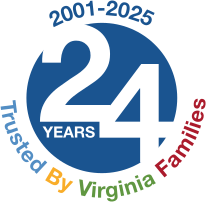Accessibility in your parks
Virginia State Parks strive to make each park as barrier-free as possible for the convenience of those with limited mobility. Each park page on this site has information on the availability of facilities for people with disabilities. Please check back often as we are updating these pages, working to provide more comprehensive information on specific facility and service availability. In the meantime, please contact the State Parks Customer Service Center at 800-933-7275 or the individual park for more information before your trip.
Personal Mobility on Trails
The Commonwealth of Virginia’s natural area preserves, state forests, state parks and wildlife management areas offer hundreds of miles of trails designed for people to enjoy (or access) the outdoors. These trails offer the public opportunities to experience and enjoy the state’s flora, fauna, cultural resources and scenic beauty.
Parks with accessible trails include Bear Creek Lake, Belle Isle, Chippokes, Claytor Lake, First Landing, James River, Kiptopeke, Lake Anna, Leesylvania, Mason Neck, Southwest Virginia Museum, Natural Tunnel, New River Trail, Pocahontas, Machicomoco and Westmoreland.
Many trails are open to wheelchairs, including manual and power wheelchairs, personal mobility assistive scooters and certain other similar devices designed primarily to assist people with disabilities. Users are encouraged to use caution when selecting trails, as many were designed for foot traffic only. Terrain might make them unsuitable for personal mobility devices.
Information on each park's accessibility
- Belle Isle State Park
- Caledon State Park
- Chippokes State Park
- Claytor Lake State Park
- Clinch River State Park
- Douthat State Park
- Fairy Stone State Park
- False Cape State Park
- First Landing State Park
- Grayson Highlands State Park
- High Bridge Trail State Park
- Holliday Lake State Park
- Hungry Mother State Park
- James River State Park
- Kiptopeke State Park
- Lake Anna State Park
- Leesylvania State Park
- Machicomoco State Park
- Mason Neck State Park
- Natural Bridge State Park
- Natural Tunnel State Park
- New River Trail State Park
- Occoneechee State Park
- Pocahontas State Park
- Powhatan State Park
- Sailor's Creek Battlefield State Park
- Seven Bends State Park
- Shenandoah River State Park
- Shot Tower State Park
- Sky Meadows State Park
- Smith Mountain Lake State Park
- Southwest Virginia Museum
- Staunton River Battlefield State Park
- Staunton River State Park
- Twin Lakes State Park
- Westmoreland State Park
- Widewater State Park
- Wilderness Road State Park
- York River State Park
As part of their commitment to making Virginia’s public lands places for all to enjoy, the Virginia Department of Conservation and Recreation, Virginia Department of Forestry, and Virginia Department of Wildlife Resources are also in the process of evaluating safety concerns and the environmental impacts of opening these trails to the use of other power-driven mobility devices by individuals with mobility disabilities. Please check this webpage periodically for updates.
